In 2010 the Vuelta celebrates its 75th anniversary. From Saturday 28 August 2010 until Sunday 19 September 2010 the riders will go from Sevilla to Madrid in about 3,337.9 kilometers.
This 65th edition starts with a spectacular team time trial by night in the streets of Sevilla in the South of Spain.
In this article you can find all details of the route (the recorrido oficial), the stage profiles and the particularities of the Tour of Spain 2010!
The particularities of the Vuelta a España 2010
The 21 stages of this 65th Tour of Spain are divided as follows:- 1 team time trial - the first stage on Saturday 28 August 2010 which will take place at night in the streets of Sevilla over a distance of 16.5 kilometers
- 1 individual time trial - with start and finish in Peñafiel over a distance of 46 kilometers, this is the 17th stage on Wednesday 15 September which will cross the Ribera del Duero area
- 11 plain stages
- 8 mountain stages
During the mountain stages the riders will have to climb 40 mountains:

- 3 hors catégorie
- 10 of the 1st category
- 14 of the 2nd category
- 13 of the 3rd category
13 stage cities will receive the Vuelta for the first time:
- starts: Alcalá de Guadaira, Caravaca de la Cruz, Villena, Vilanova, Rincón de Soto, Solares, Peñafiel, Piedrahita
- finishes: Valdepeñas de Jaén, Orihuela, Vilanova i la Geltrú, Cotobello, Peñafiel, Bola del Mundo
The golden jersey becomes ... red
According to the rumours this change should have taken place this year already, but in 2010 it will finally become reality: the golden jersey makes place for his red replacement!This will allow to clearly recognise the leader's jersey of the Vuelta, especially next to the Tour de France's yellow jersey and together with the Giro's pink jersey this will become a new symbol of one of the three Grand Tours.
The Vuelta has adopted the red colour as its main colour today and yellow is now being used as a supporting colour.
An overview of all the stages
| # | type | date | start | finish | distance |
|---|---|---|---|---|---|
| 1 | team time trial | Sa. 28 August 2010 | Sevilla | Sevilla | 16,5 km |
| 2 | Plain | Su. 29 August 2010 | Alcalá de Guadaíra | Marbella | 173 km |
| 3 | Mountain | Mo. 30 August 2010 | Marbella | Malaga | 156 km |
| 4 | Plain | Tu. 31 August 2010 | Malaga | Valdepeñas de Jaen | 177 km |
| 5 | Plain | We. 1 Sept. 2010 | Guadix | Lorca | 194 km |
| 6 | Plain | Th. 2 Sept. 2010 | Caravaca de Cruz | Murcia | 144 km |
| 7 | Plain | Fr. 3 Sept. 2010 | Murcia | Orihuela | 170 km |
| 8 | Mountain | Sa. 4 Sept. 2010 | Villena | Xorret del Catí | 188,8 km |
| 9 | Mountain | Su. 5 Sept. 2010 | Calpe | Alcoy | 187 km |
| - | Rest day | Mo. 6 Sept. 2010 | Tarragona | ||
| 10 | Mountain | Tu. 7 Sept. 2010 | Taragona | Vilanova i la Geltrú | 173,7 km |
| 11 | Mountain | We. 8 Sept. 2010 | Vilanova i la Geltrú | Andorra (Vallnord / sector Pal) | 208 km |
| 12 | Plain | Th. 9 Sept. 2010 | Andorra la Vella | Lleida | 175 km |
| 13 | Plain | Fr. 10 Sept. 2010 | Rincón de Soto | Burgos | 193,7 km |
| 14 | Mountain | Sa. 11 Sept. 2010 | Burgos | Peña Cabarga | 178,8 km |
| 15 | Mountain | Su. 12 Sept. 2010 | Solares | Lagos de Covadonga | 170 km |
| 16 | Mountain | Mo. 13 Sept. 2010 | Gijón | Cotobello | 179,3 km |
| - | Rest day | Tu. 14 Sept. 2010 | Peñafiel | ||
| 17 | individual time trial | We. 15 Sept. 2010 | Peñafiel | Peñafiel | 46 km |
| 18 | Plain | Th. 16 Sept. 2010 | Valladolid | Salamanca | 153 km |
| 19 | Plain | Fr. 17 Sept. 2010 | Piedrahita | Toledo | 200 km |
| 20 | Mountain | Sa. 18 Sept. 2010 | San Martín de Valdeiglesias | Bola del Mundo (Etapa 7 Estrellas Comunidad de Madrid) | 168,8 km |
| 21 | Plain | Su. 19 Sept. 2010 | San Sebastián de los Reyes | Madrid | 100 km |
The map of the Vuelta a España 2010 route
Below you can find the official map of the Tour of Spain 2010 route. Click on the map to zoom in (and if necessary on the arrows in the right lower corner to watch it full size).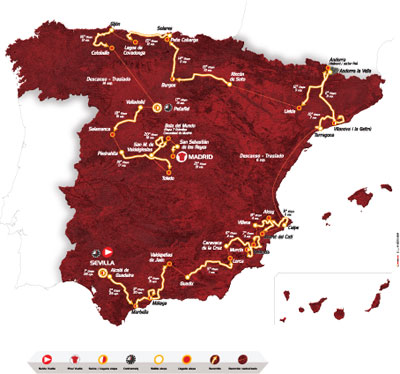
The video of the Tour of Spain 2010 route
Below you'll find a movie of the Vuelta a España 2010 route:La vidéo du parcours du Tour of Spain 2010 - © Unipublic
The stages of the Tour of Spain 2010 presented one by one, with the stage profiles
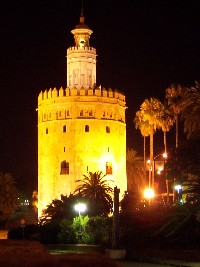
CONTINUE READING AFTER THIS ADVERTISEMENT
Stage 1 - Saturday 28 August 2010 - team time trial - Sevilla > Sevilla - 16,5 km
The Tour of Spain didn't come to Sevilla since 15 years and this time it will come back for a nightly visit with a 16.5 kilometer team time trial to make it a good start of the 75th anniversary of the Vuelta.Even though it's a completely flat stage this team time trial will definitely not be easy: the first 5 kilometers in the center of Sevilla are very technical and the riders must form a real team to get through it without any trouble. The rest of the stage is composed of long straight lines and during the stage the riders will see the Sevilla arenas and pass over the Triana bridge. The finish line will be below the Torre del Oro (the golden tower) (photo - © dubaduba).
Below you'll find this stage's profile (click on it to zoom in):
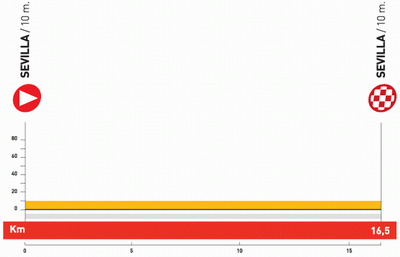
Stage 2 - Sunday 29 August 2010 - plain - Alcalá de Guadaíra > Marbella - 173 km
After the start from Alcalá de Guadaíra - which the Vuelta visits for the very first time in its 75 year old history - the riders will have to climb two third category mountains in this "plain" stage: the Alto de Pruna (620 m), whose top will be after 75 kilometers, and the Alto de Ronda (1.130 m) at 43 kilometers from the finish.After the first climb follows a 32 kilometer long descent and a final 11 kilometer long flat part: the perfect occasion for the sprinter teams to prepare a the first mass sprint of this Vuelta at the finish in Marbella (stage city for the 4th time, the last one was in 1996).
Below you'll find this stage's profile (click on it to zoom in):
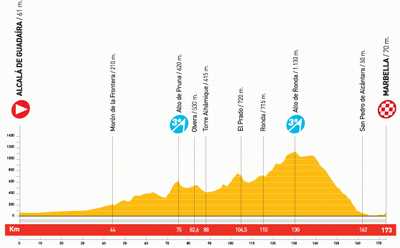
Stage 3 - Monday 30 August 2010 - mountain stage - Marbella > Malaga - 156 km
Immediately after the start from Marbella this first mountain stage starts with a third category climb, the Puerto de Ojén (550 m with a 4.8% average slope). About 80 kilometers further is the top of the Puerto del Léon (1st category, 905 m, 4.91% average slope) which will be climbed from Malaga where the peloton passes for the first time after 67 kilometers. After the descent of this mountain there will only be a few kilometers before a new climb of this mountain. After the second descent follows a small plain part, but the riders will finish the stage with a one and a half kilometer climb to the castle of Gibralfaro in Malaga!Below you'll find this stage's profile (click on it to zoom in):
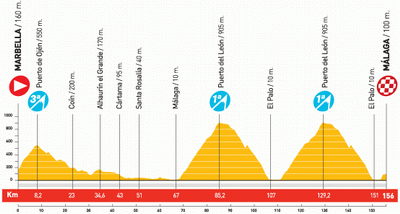
Stage 4 - Tuesday 31 August 2010 - plain - Malaga > Valdepeñas de Jaen - 177 km
After an easy and flat start of this stage the riders will climb three mountains before the finish in Valdepeñas de Jaen where the Vuelta never stopped before: the Alto Ventas de Zafarraya (2nd category, 910 m), the Alto de Montefrio (3rd category, 1.040 m) and finally the Puerto de Valdepeñas (2nd category, 1.100 m) at about 6 kilometers from the finish.Below you'll find this stage's profile (click on it to zoom in):
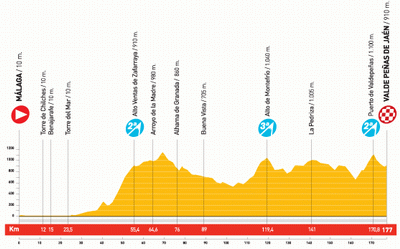
CONTINUE READING AFTER THIS ADVERTISEMENT
Stage 5 - Wednesday 1 September 2010 - plain - Guadix > Lorca - 194 km
This stage will either be the perfect occasion for a leading group which will go on until the finish or for a mass sprint.Below you'll find this stage's profile (click on it to zoom in):
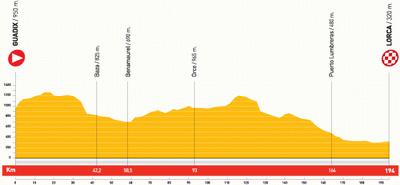
Stage 6 - Thursday 2 September 2010 - plain - Caravaca de Cruz > Murcia - 144 km
This is the second shortest stage and will start in Caravaca de Cruz. It will follow a completely flat route. At about 10 kilometers from the finish the riders will however find a short climb: the Alto de la Cresta del Gallo (2nd category, 370 m). Since it's positioned at only a few kilometers from the finish, it could well be an additional difficulty for the riders who were expecting a mass sprint finish in Murcia.Below you'll find this stage's profile (click on it to zoom in):

Stage 7 - Friday 3 September 2010 - plain - Murcia > Orihuela - 170 km
This stage will connect Murcia, a city which is used to receive the Vuelta, to Orihuela which will receive the Vuelta for the first time! The first 100 kilometers of this stage will follow a flat route and the top of the first difficulty of this stage, the Alto de Hondon de los Frailes (3rd category, 500 m), will be at 58 kilometers from the finish. The sprinters teams will thus most be probably be able to correctly position their rocket man for a stage victory in Orihuela.Below you'll find this stage's profile (click on it to zoom in):

Stage 8 - Saturday 4 September 2010 - mountain stage - Villena > Xorret del Cati - 188,8 km
This Saturday the riders will have another mountain stage. Even though they'll have to wait until the end of the stage for a first category climb, this stage will be rather difficult and will immediately after the start from Villena (which the Vuelta visits for the first time) start the climb to the top of the Puerto de Onil (3rd category, 1O30 m). After a hilly part, 3 climbs of the 2nd category are waiting for the riders: the Puerto de Tudons (990 m), the Puerto de Torremanzanas (880 m) and the Puerto de Carrasqueta (1025 m). The last climb of this stage is the Alto del Catí (1st category, 1100 m) and it will probably give a spicy end to this stage, as it did the 4 previous times the Vuelta finished here.Below you'll find this stage's profile (click on it to zoom in):
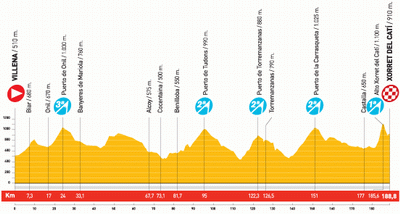
CONTINUE READING AFTER THIS ADVERTISEMENT
Stage 9 - Sunday 5 September 2010 - mountain stage - Calpe > Alcoy - 187 km
The second mountain stage of this superb weekend will lead the riders from Calpe, where several riders did their winter training (Johnny Hoogerland of the Vacansoleil Pro Cycling Team, the whole Katusha team, ...), to Alcoy over a 187 kilometer distance and with no less than 6 climb. After 50 flat kilometers starts the first climb to the top of the Coll de Rates (2nd category, 625 m). It will be followed by the combination of the Alto de Guadalest (2nd category, 680 m), the Alto de Confrides (3rd category, 980 m), the Alto de Tudons (2nd category, 1025 m), the Puerto de Torremanzanas (2nd category, 890 m) and finally the Puerto de Benifallim (3rd category, 1030 m) before the descent towards the finish in Alcoy.After this great mountain weekend the general ranking of this 65th Vuelta will probably start to show the first differences.
Below you'll find this stage's profile (click on it to zoom in):
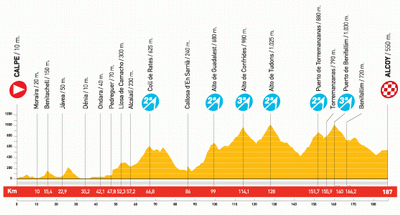
Stage 10 - Tuesday 7 September 2010 - mountain stage - Tarragona > Vilanova i la Geltrú - 173,7 km
After the first well deserved rest day it's time for the 10th stage. After 120 kilometers the riders will pass the finish line for the first time. However, the stage will not stop there since they'll follow the coast line towards the climb of the Alto del Rat Penat (480 m), short but steep. The sprinters who chose this stage will either have to pass this climb with parts up to 20 to 22% or get back on the best climbers in the last 30 kilometers to pass the finish line first when they pass it for the second time!Below you'll find this stage's profile (click on it to zoom in):
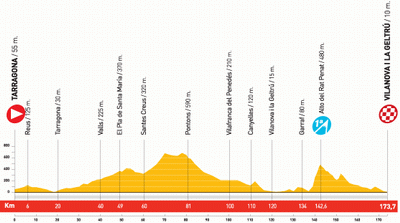
Stage 11 - Wednesday 8 September 2010 - mountain stage - Vilanova i la Geltrú > Andorra (Vallnord / secteur Pal) - 208 km
Just like in the Tour de France 2009 the 75th anniversary of the Vuelta is celebrated in style with the stage to Andorra as the longest stage. The 208 kilometers of this stage are almost always climbing towards the mountain top finish (hors catégorie) in Pal in the Vallnord ski station. Yet another stage where the best climber, who will wear a new jersey in 2010 (because this jersey was red and the leader's jersey which was gold also becomes red in 2010, the best climber's jersey will most probably change ... maybe it'll adopt the same look with polka dots like in the Tour and in many other cycling races?), can take some additional points to comfort his position!Below you'll find this stage's profile (click on it to zoom in):
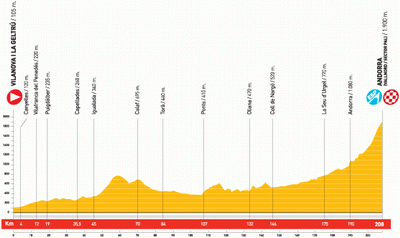
Stage 12 - Thursday 9 September 2010 - plain - Andorra la Vella > Lleida - 175 km
Again like in the Tour de France 2009 the next day's stage of the 65th Vuelta will also start in Andorra la Vella.Despite the climb of the Coll de Boixol which has its top at kilometer 57 (118 kilometers from the finish), the sprinters' teams will probably prepare a mass sprint at the end of this stage.
Below you'll find this stage's profile (click on it to zoom in):
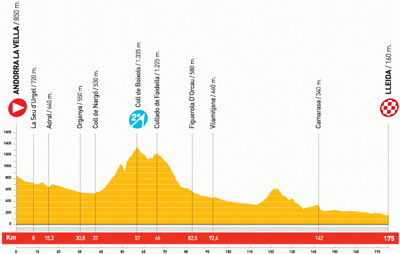
CONTINUE READING AFTER THIS ADVERTISEMENT
Stage 13 - Friday 10 September 2010 - plain - Rincón de Soto > Burgos - 193,7 km
Between Rincón de Soto and Burgos the riders will have two 3rd category climbs: the Alto de la Pradilla (1210 m) and the Alto de Valmala (1120 m). The top of the first climb will be at kilometer 135, while the second will be attained at about 30 kilometers from the finish. The perfect occasion for a leading group which could stay ahead until the finish.Below you'll find this stage's profile (click on it to zoom in):
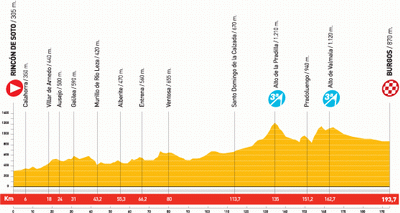
Stage 14 - Saturday 11 September 2010 - mountain stage - Burgos > Peña Cabarga - 178,8 km
After two plain stages, this weekend and on the following Monday the riders will again find 3 mountain stages. This Saturday it all starts with a stage with 4 difficulties, one of which being the climb to the mountain top finish in Peña Cabarga where the Vuelta came for the last time in 1979.After 78 kilometers the riders will be on the top of the Alto de Bocos (780 m, 3rd category) and after its descent they will immediately continue with the climb of the Portillo de Lunada (1350 m, 2nd category), followed by the Alto de Caracol (820 m, 2nd category). When the riders arrive at the top of this third climb they will start their descent to sea level before starting the last climb: a 1st category mountain with an average slope of 10%! The general ranking could well look a bit different after this stage!
Below you'll find this stage's profile (click on it to zoom in):
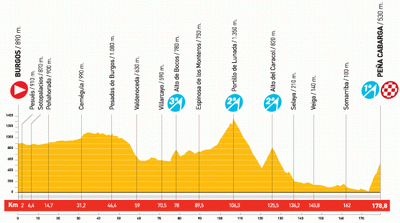
Stage 15 - Sunday 12 September 2010 - mountain stage - Solares > Lagos de Covadonga - 170 km
The second episode of this mountain weekend starts with about 150 flat kilometers following the coast line. The perfect occasion for one or more riders to create a leading group. However, at the end of the stage they will find a difficult climb towards the Covadonga Lakes.This hors catégorie climb is regularly part of the Tour of Spain since 1983 and is 12,6 kilometers long with a 7.3% average slope (height difference: 1056 m). To get to the top at a 1110 meters altitude, the riders -at 7 kilometers from the finish- the riders will have to get over the most difficult part at La Huesera: over 13% for a bit more than 500 meters. The last few years this part was often decisive for the stage win. The last time the Vuelta visited this mountain, in 2007, the stage victory was for Vladimir Efimkin. This climb is often seen as the Spanish Alpe d'Huez.
Below you'll find this stage's profile (click on it to zoom in):
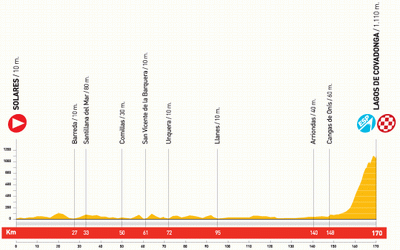
Stage 16 - Monday 13 September 2010 - mountain stage - Gijón > Cotobello - 179,3 km
This Monday the third mountain stage in row is awaiting the riders ... fortunately they can get some rest the next day.With no less than three 1st category climbs (one of which being the never used before climb to Cotobello) and one 3rd category climb this stage is one of the most difficult ones. After a bit more than 45 kilometers from the start in Gijón the riders already reach the top of the Alto de la Cabruñana (3rd category, 375 m). This will be followed by the 3 first category climbs: first the Alto de San Lorenzo (1350 m) with slopes up to 15%, followed by the Puerto de la Cobertoria (1174 m, average slope: 8.6%) and finally the 10 kilometer long climb to Cotobello with a 8.1% average slope with a maximum of 12% at several parts.
Below you'll find this stage's profile (click on it to zoom in):
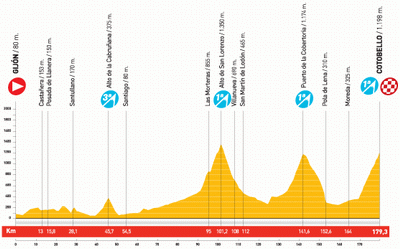
CONTINUE READING AFTER THIS ADVERTISEMENT
Stage 17 - Wednesday 15 September 2010 - individual time trial - Peñafiel > Peñafiel - 46 km
After the second rest day, it's time for the only individual time trial of this 65th Vuelta. With the finish and the start in a city which the Vuelta never visited before, Peñafiel, this stage proposes a completely flat route with long straight lines and thus perfect for time trial experts. That is, if they manage to get through the two first weeks without too much trouble!Below you'll find this stage's profile (click on it to zoom in):
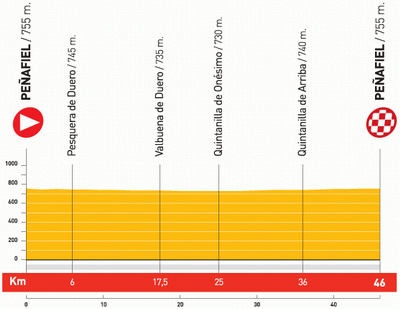
Stage 18 - Thursday 16 September 2010 - plain - Valladolid > Salamanca - 153 km
With its start from Valladolid this is a historical stage: not only because the Vuelta starts for the 34th time in this 65th edition but also because Valladolid was on 29 April 1935 (the Vuelta took place in April/May until 1995, it only found it's current positioning in August/September in 1996) the very first start city of the Vuelta.In this plain stage the sprinters will most probably try to pass the finish line first in Salamanca, if the wind is not going to spoil their plans and split up the peloton ...
Below you'll find this stage's profile (click on it to zoom in):
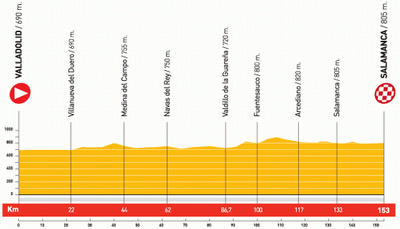
Stage 19 - Friday 17 September 2010 - plain - Piedrahita > Toledo - 200 km
With its 200 kilometers this is the second longest stage. After the start from Piedrahita, which will be visited for the very first time by the Vuelta, the riders will immediately start the climb of the Puerto de Chia (2nd category, 1670 m), but apart from this climb this stage's route is completely flat. The riders who still have some energy left will thus have a perfect occasion to get away in a leading group and try to get the stage win, except if the sprinters teams are able to get back on them before the finish.Below you'll find this stage's profile (click on it to zoom in):
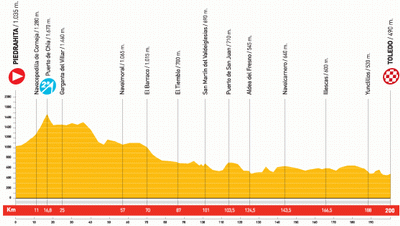
Stage 20 - Saturday 18 September 2010 - mountain stage - San Martín de Valdeiglesias > Bola del Mundo (Etapa 7 Estrellas Communidad de Madrid) - 168,8 km
As usual, the Vuelta proposes a difficult mountain stage at the end which might lead to some final changes in the general ranking and thus keep some surprises until the very end.After the start from San Martín de Valdeiglesias the stage starts with a quite easy climb to the top of the Puerto de la Cruz Verde (3rd category, 1256 m). Than, the difficult part of the stage starts: first of all the climb to the Alto del Leon (1st category, 1515 m). After a short descent and a flat part they'll start the climb to the top of the Puerto de Navacerrada (1st category, 1870 m). After the descent towards Guadarrama the riders will climb the same mountain again. Once they arrive at the top, they will however continue for 3 kilometers to the top which was never visited before by the Vuelta, the Alto de las Guarramillas which is better known as the Bola del Mundo (hors catégorie, 2250 m). In this last part the riders will find slopes up to 12.5%.
Below you'll find this stage's profile (click on it to zoom in):
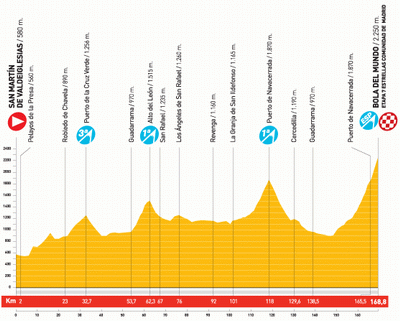
CONTINUE READING AFTER THIS ADVERTISEMENT
Stage 21 - Sunday 19 September 2010 - plain - San Sebastián de los Reyes > Madrid - 100 km
For this stage we know beforehand it will be done in slow motion while drinking a glass of champagne.For this edition the Vuelta organisor, Unipublic, decided to make it a very short stage of exactly 100 kilometers. After the start from San Sebastián de los Reyes the riders will thus rapidly find the usual circuit on the Paseo de la Castellana. This 6 kilometer circuit will be done about 8 times before -most probably- a sprinter will cross the finish line first on the Plaza de la Cibeles in Madrid!
Below you'll find this stage's profile (click on it to zoom in):
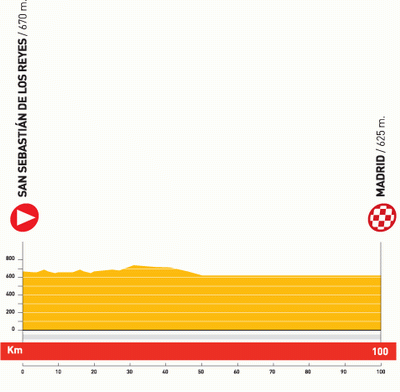
Vond u dit artikel interessant? Laat het uw vrienden op Facebook weten door op de buttons hieronder te klikken!
11 comments | 41123 views
this publication is published in: Vuelta a España | Vuelta a España 2010





 by Bernard over
by Bernard over  by Stuart over
by Stuart over  by Kiera over
by Kiera over
On va voir ce que cela va donner, mais je pense que ce ne sera pas une Vuelta très sélective.Et vous?
Pour le changement de couleur du maillot du leader....cela va faire bizarre, mais cela reste cohérent puisque les équipes sportives espagnoles sont toutes en rouge.
Je trouve par contre que le parcours est très décousu...on ne dirait pas un Tour d'Espagne mais 4 petits tours qui s'enchainent(un au Sud, un au centre, un au Nord-est et un au Nord-Ouest...Mais bon, c'est un détail).
L'ENORME nouveauté est le contre la montre nocturne....cela peut être très joli à voir.....et une boucherie pour les courreurs.
Très bel article
plus de 3000 kms , les pauvres petits gars , j ai mal aux cuisses rien que d y penser
Graag wil ik hier melden dat op 29/8/2008 ik een breed verslag heb gebracht op de eerste Vuelta van 1935 ter ere van renner Antoine Dignef uit mijn stad Landen die toen de eerste rit had gewonnen.
http:/blog.seniorennet.be/wilfried_1944
Désolé de ne pas avoir répondu plus tôt ... j'ai mis du temps pour publier les profils des étapes !! Jean, après avoir regardé chacune des étapes (ce que tout le monde peut désormais faire dans l'article ci-dessus avec les profils de chacune des étapes), je pense qu'il s'agit effectivement d'une Vuelta légèrement moins sélective que celle de cette année par exemple ... tout en restant quand même assez montagneuse ! A voir ce que ça va donner !
 Journée, bedankt voor deze reactie. Jammer dat er op uw blog geen kalenderfunctie of een zoekmachine te vinden is waarmee een artikeltje makkelijk te zoeken zou zijn. Voor diegenen die het verslagje willen lezen, heb ik via een lange omweg een link naar het betreffende artikeltje weten samen te stellen :-).
Journée, bedankt voor deze reactie. Jammer dat er op uw blog geen kalenderfunctie of een zoekmachine te vinden is waarmee een artikeltje makkelijk te zoeken zou zijn. Voor diegenen die het verslagje willen lezen, heb ik via een lange omweg een link naar het betreffende artikeltje weten samen te stellen :-).
Sinon comme tu dis on peut effectivemen regretter qu'il y a 4 petits tours locaux qui s'enchaînent plutôt qu'un vrai Tour d'Espagne. Les équipes risquent d'ailleurs de se plaindre des transferts nécessaires pour relier ces 4 petits tours ...
certes ca manque de grosses etapes de montagne mais que les gros cols soient plus rares ne fait que les mettre plus en valeur . le directeur de la vuelta semble vouloir plus privilegier des etapes a petits cols successifs chaque jour pour dynamiser la course et tenir son audimat , ca devrait donner des idées a ASO dans la conception de certains de ses etapes qui souffrent un peu de classisisme avec ces cols traditionnels systematiquement privilégiés au detriment de petits cols champetres
What about teams, riders, and their numbers?
@katie lax : check out my blog post The participating riders for the 2010 Tour of Spain and their numbers!
Pourquoi ne pas prendre l 'antenne plus tot demain ?
C'est quand meme une grande étape.
Excellent article (oui je l'ai lu un an après :) mais j'avais envie de me remémorer le parcours, c'est chose faite grâce à cette publication très complète ), pourrais-tu me prévenir si tu as publié quelque chose de similaire sur le giro 2012 ou le tour 2012 ? Merci beaucoup et bonne continuation !
Bonjour Steve et merci :-).
Pour le Giro 2012 j'ai écrit un article similaire sous le titre Le Giro d'Italia 2012 - le parcours : retour à un Giro plus raisonnable (cartes & profils). En ce qui concerne le Tour de France 2012 c'est un petit peu plus réparti en différents articles (comme le jour de la présentation officielle je n'ai rien appris de nouveau) qui se trouvent tous dans la rubrique Tour de France 2012.